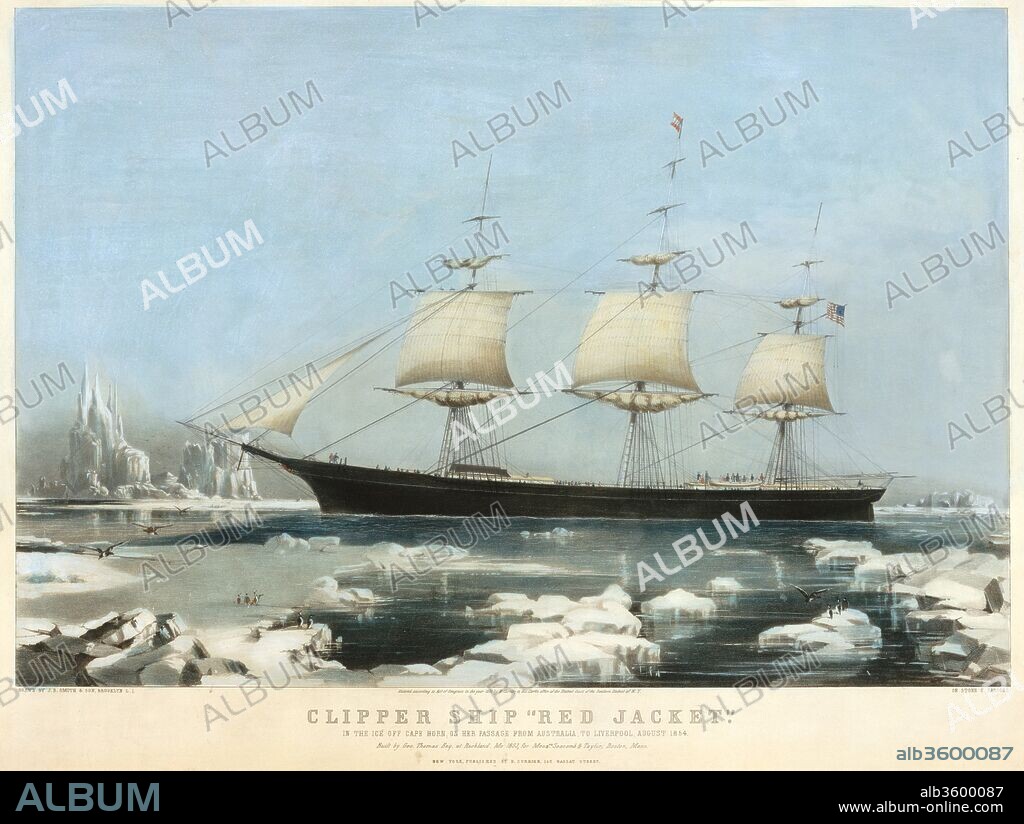alb3600087
CHARLES PARSONS, AFTER JOSEPH B. SMITH. Clipper Ship "Red Jacket"-In the Ice off Cape Horn, on Her Passage from Australia, to Liverpool, August 1854

|
Add to another lightbox |
|
Add to another lightbox |



Buy this image.
Select the use:

Title:
Clipper Ship "Red Jacket"-In the Ice off Cape Horn, on Her Passage from Australia, to Liverpool, August 1854
Caption:
Clipper Ship "Red Jacket" - In the Ice off Cape Horn, on Her Passage from Australia, to Liverpool, August 1854. Artist: Charles Parsons (American (born England), Hampshire 1821-1910 New York); After Joseph B. Smith (American, New York, 1798-1876). Dimensions: Image: 16 1/8 × 23 11/16 in. (41 × 60.1 cm)
Sheet: 21 1/4 × 27 9/16 in. (54 × 70 cm). Publisher: Lithographed and published by Nathaniel Currier (American, Roxbury, Massachusetts 1813-1888 New York). Date: 1855.
"Red Jacket" ranks among the largest and fastest American clipper ships ever built. Designed with a 255-foot deck by Boston-based Samuel Hartt Pook for the owners Seacombe and Taylor, it was built by George Thomas in Rockland, Maine, who launched it in November 1853. The name "Red Jacket" refers to Sa Go Ye Wat Ha, ("he who keeps them awake"), the great Seneca orator and leader who had aided the British during the American Revolution, earning him his British red uniform and nickname. After the Revolution, Sagoyewatha championed peace, became a defender of native American culture and a spokesman for the Iroquois confederacy in 1792, when he led Iroquois chiefs to Philadelphia, where they agreed to mediate in frontier war. During the War of 1812, Sagoyewatha fought with the Americans against the British.
In January 1854, "Red Jacket" made her first voyage from New York across the north Atlantic to Liverpool, England, where a new British owner outfitted her for Australian immigrant and cargo transport. In May 1854, the White Star Line chartered the ship to sail to Melbourne, Australia, where it arrived after sixty-nine days with approximately 450 passengers (16 of them traveling in first class cabins) -- the second fastest record at that time. In 1855, Nathaniel Currier published this print depicting the "Red Jacket" in the midst of its return journey, when it was trapped for four days in an ice field off Cape Horn. The route involved sailing round Cape Horn at the tip of South America, where, at certain times of the year, fierce winds, large waves and icebergs and ice floes floating from Antartica made the seas between the South Pacific and South Atlantic treacherous to navigate. Despite this delay, the ship reached Liverpool in seventy-three days with all its passengers and a valuable gold cargo -- reportedly about 45,000 ounces. This clipper's speed became a selling point to future passengers; "Red Jacket" continued to transport passengers and cargo back and forth between England and Australia until the early 1860s.
Technique/material:
hand-colored lithograph
Museum:
Metropolitan Museum of Art, New York, USA
Publisher:
Lithographed and published by Nathaniel Currier (American, Roxbury, Massachusetts 1813-1888 New York)
Credit:
Album / Metropolitan Museum of Art, NY
Releases:
Model: No - Property: No
Rights questions?
Rights questions?
Image size:
4200 x 3164 px | 38.0 MB
Print size:
35.6 x 26.8 cm | 14.0 x 10.5 in (300 dpi)
Keywords:
AFTER JOSEPH B. SMITH • CHARLES PARSONS • DRAWINGS AND PRINTS • HAND-COLORED LITHOGRAPH • LITHOGRAPHED AND PUBLISHED BY NATHANIEL CURRIER (AMERICAN, ROXBURY, MASSACHUSETTS 1813-1888 NEW YORK) • LITHOGRAPHS • METROPOLITAN MUSEUM OF ART, NEW YORK, USA • NORTH AND CENTRAL AMERICA • PLANOGRAPHIC PRINTS • PRINTS • UNITED STATES
 Pinterest
Pinterest Twitter
Twitter Facebook
Facebook Copy link
Copy link Email
Email
